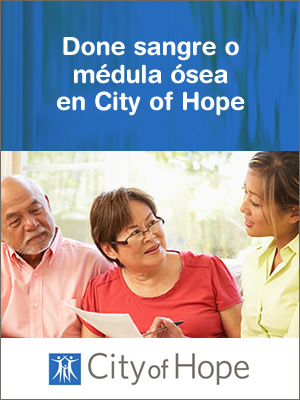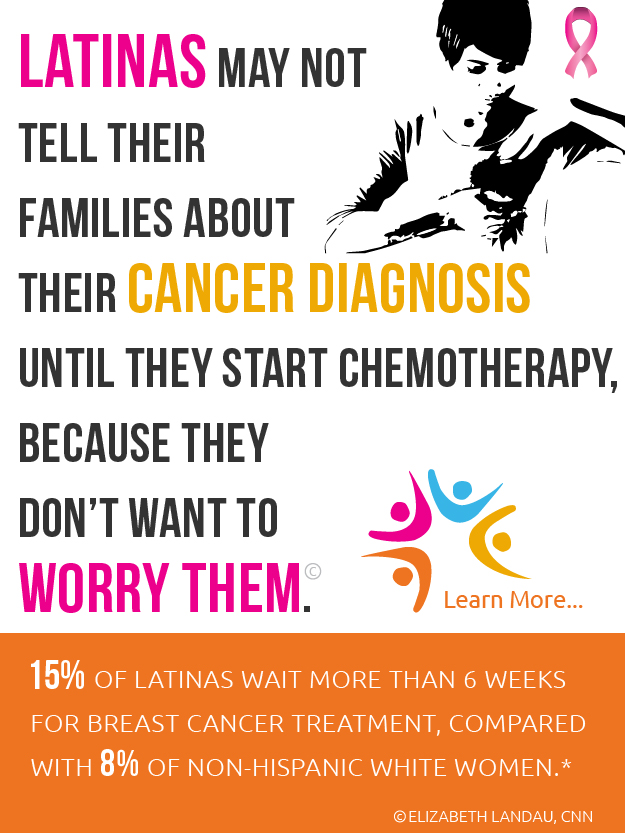
We Still Don’t Know Enough About Latinas and Breast Cancer
02/12/2015 08:58AM | 7719 viewsThe woman caller named Rosario said she was anxious. She had lumps on her breast. Could we help her get a mammogram?
Latinas Contra Cancer (LCC) did help Rosario, who within weeks, was screened and diagnosed with third stage breast cancer. She is 41.
Unfortunately, San Jose, California based Latinas Contra Cancer, sees the story of late detection repeat itself too often. In the month of August 2014 alone, 11 Spanish speaking Latinas at the local cancer center where LCC provides services, were diagnosed with or being treated for breast cancer. Only one patient was stage one. The others were diagnosed at stage 3 and 4.
Increasingly, research shows that Latinas are being diagnosed younger and with larger tumors. Unfortunately there is not enough research to pinpoint why this is so.
Breast cancer is the most common type of cancer and the leading cause of cancer death in Latinas.1 As reported in the Women’s Minority Health2 page of the Office of Women’s Health, even with early diagnosis, Latinas are more likely to have tumors that are larger and harder to treat than white women.
So even while Latinas Contra Cancer presses for increased research, for over a decade LCC has been taking steps to promote mammograms and early intervention with the goal of reducing the mortality rate.
LCC now hosts four free clinics a year with our business associate, Gardner Family Health Network, to get low income, Spanish-speaking women screened, and moved into medical homes. Latinas Contra Cancer recruits and educates these women from the community, helps prepare their medical forms in Spanish, and transports up to 8 to 10 women per clinic.
The goal in 2015 is to educate up to 200 women and achieve 40 mammograms. It’s a small number and we’ve set our sights on tripling those numbers. Limited resources keep us from scaling up. But one woman screened is one more Latina we hope we can save.
Still, our history of educating this group, shows it is not as simple as offering a free mammogram. We know from years of promoting screening and early intervention that fear, myth and misinformation, exacerbated by low income, language and cultural barriers, increase the risk.
To address these barriers, we launched in 2005 a culturally and linguistically appropriate tool using the bingo game as a model. Using Breast Health Bingo, we have educated over 2373 women and some men about breast cancer risk, the importance of knowing family history, healthy eating and exercise. We know it is not enough to tell somebody to do something for their own welfare, but must address cultural beliefs, income and access issues that are also barriers to early intervention.
Latinos are the largest minority group in the U.S. By 2050, they will represent one third of the U.S. population. This is a demographic shift of paramount proportions, and thus, it is imperative to address health disparities impacting this rapidly growing segment of the U.S. population.
Nationally, nearly 30 percent of Latinos are uninsured (Council of La Raza, 2012). In 2012, approximately half of all foreign-born Latinos (49%), lacked health insurance, while among non-U.S. citizen immigrant Latinos, 61percent had no health insurance. (Pew Research, Hispanic Trends Project, April 2014).
It is too early to tell if the Affordable Care Act and Covered California will have any significant impact on these numbers, especially given the hundreds of thousands of undocumented legislated out of applying for health insurance.
As a population, Latinos are disproportionally low-income. In addition, Latinos are less likely to have a regular source of medical care, when compared to non-Latinos. Many are Spanish speakers with little or no English proficiency. Pew Research reports that 33 percent of Latinos say they do not speak English well
It is also important to note that Latinos are the most underrepresented minority group in the health care workforce nationwide. Of the 10 thousand oncologists in the country, the number of Latino oncologists is difficult to determine, and desperately low. This situation exacerbates linguistic and cultural barriers for Latino patients. Hence, there is a critical need for culturally relevant services.
As a result of the various issues affecting them socio-economically, when it comes to cancer, Latinos have low rates of early cancer screenings and detection, and are often diagnosed in later stages. Thus, survival rates are disproportionately lower than non-Latinos. (Where Cancer Meets Culture, Mia James, CancerConnect.com).
Latinas Contra Cancer has worked to address both systems and cultural barriers. In our 2015 campaign we have taken our bingo game one step further, teaching participants about the environmental risks in their home, with a goal of diminishing their toxic footprint and breast cancer risk.
Not only do we increase their awareness, we send them home with a bag of non- toxic products so women can begin to make change in their household.
Beyond that, we identify those women 40 years of age and older who need screening or rescreening. Unfortunately too many Latinas do not realize they need to rescreen at least every two years according to the latest recommendations, or yearly, if family history and other factors indicate it.
Once identified, our promotora helps sign them up with the Gardner Clinic Day for their clinical breast exam, and then, onto a mammogram, hopefully all within a month’s time. And we continue to call them until we are assured they are screened. Of the first 31 women we got screened in 2013, three had suspicious readings. One was detected with breast cancer. In 2014, 20 women got screened. Rosario was one of those women and following her stage three diagnosis she went into treatment at the Sobrato Cancer Center where we have navigated over 125 Latinas with breast cancer. 58% of them are 50 years of age and younger, the youngest was 28 years old. Out of the 125 Latinas, so far, 10 women (8%) died, the youngest was 31.
These numbers are what drive Latinas Contra Cancer to not only promote yearly screenings, but to recommend mammograms starting at age 40 which was the long time practice until 2009.
We cannot agree with the United States Preventive Services Task Force (USPSTF)3 that recommended in 2009 that women should start regular, biennial screening mammography at the age of 50.
The USPSTF, which will release its latest 5-year review this year, did not demonstrate in their 2009 recommendations that they looked at the specific issues confronting Latinas. We argue that lack of sufficient research including subpopulation studies, low-income, lack of awareness and regular access to care, exacerbated by other social determinants (risk factors in one’s living and working conditions as well as lifestyle choices) increase Latina breast cancer risk.
The Task Force said they could determine minimal benefits from screening for women under age 50, and perhaps, more harm from over screening and overtreatment. We cannot judge the harm posed by over screening since as a group, Latinas are under-screened and there is no specific research as to harms caused. The Susan G. Komen Foundation put the Latina screening rate at 64 percent in 2012. And they determined that women with insurance were twice as likely to get screened as the uninsured.
Until there is a much greater understanding of the genetic and biological factors, coupled with more research on the social determinants that specifically impact Latina breast cancer risk, we urge Latinas to know their family history, get educated about breast cancer and get a baseline screening at age 40.
1. http://ww5.komen.org/BreastCancer/RacialEthnicIssuesinScreening.html
2.
http://womenshealth.gov/minority-health/latinas/breast-cancer.html
3.
http://www.uspreventiveservicestaskforce.org/Page/Topic/recommendation-summary/breast-cancer-screening











Post your Comment
Please login or sign up to comment
Comments